| Hello Friends, I hope you are well, I know it has been a while since I dropped in to say hello. It has been a somewhat slow and unusual time here. There’s been a lot of navigating of change and trying to figure out what life looks like now that I am (most gratefully and thankfully) emerging from a chapter of ill health. I was so focussed on getting better and getting back to “normal” that I don’t think I truly appreciated just how consuming and exhausting normal can be. So I am once more thanking you for your continued support as I have roamed around another uncertain and musically quiet chapter. How has the start of 2024 been for you? Please do hit the reply button if you have time, I’d love to hear from you. I do have an update for you though. As some of you may have seen I have started a duo with my good friend Kathleen Pilkinton. We are re-imagining and re-working songs from the folk world, both the traditional and the modern (and probably a football song or two along the way) We have our first couple of shows this April. One in London and one in Lincolnshire. Perhaps we may see you there? We are building our set list at the moment so if you have any suggestions of songs you’d love to hear us try then we’d be all ears. |
 |
| Tickets and info London https://www.greennote.co.uk/production/paper-fence/ Tickets and info Lincolnshire https://www.alfordcornexchange.co.uk/eventdetails/442 There’s a bit more to share and tell, so I shall write again soon, but for now I shall once more thank you for continuing to be here and for your support. Tara for now Minnie xx |
Spring, shows, songs…
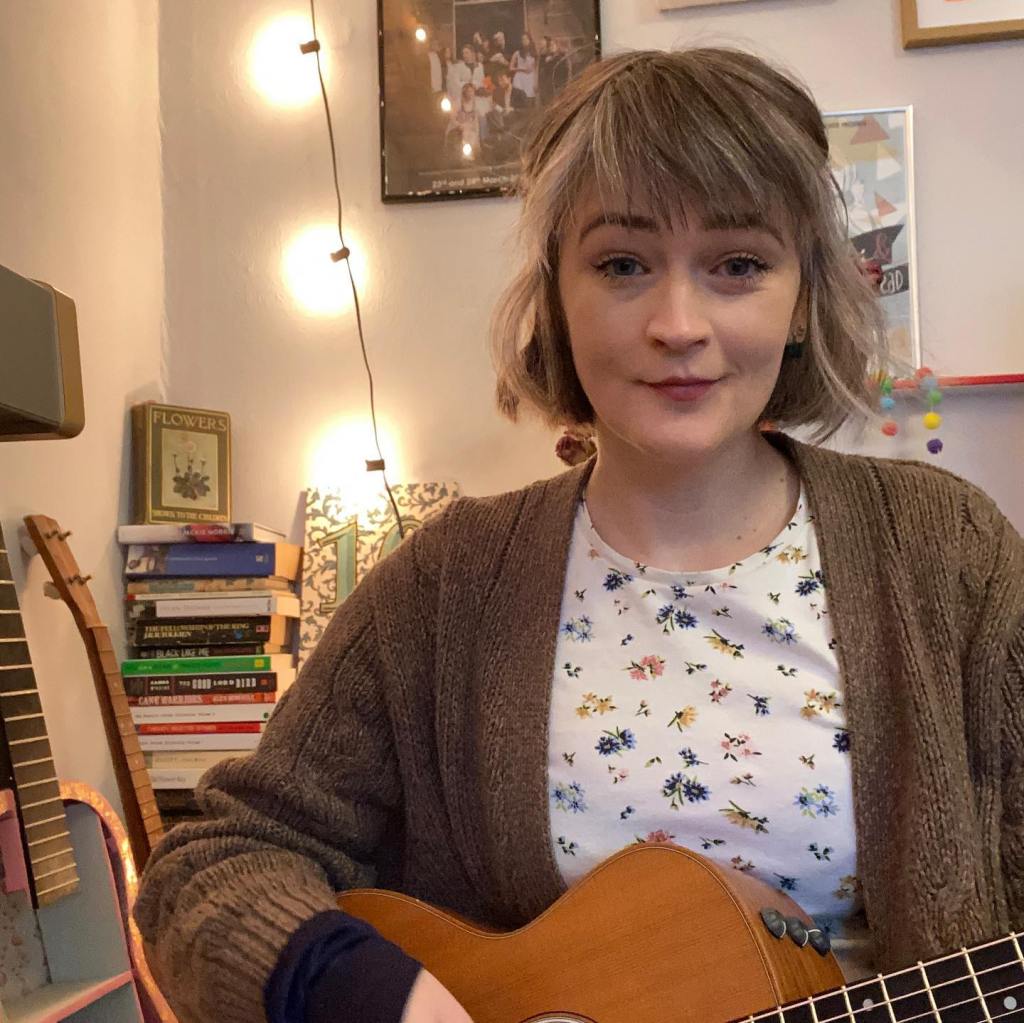
Hello Friends,
I haven’t written for a while. I hope this New year has been treating you kindly. I always feel a little that Spring has more of a New year feeling to it, nature starts to wake up from hibernation at that point, and I think we do a little too. So, if you’ve been hibernating up until now, then, well, I think that’s just as nature intended. I haven’t been hibernating as such but I am having to lean in to a slightly slower pace of life as I give my body and mind a bit of time to catch up on the last couple of tumultuous (great word) years.
This year has offered me some really magical moments so far. Being back out playing live shows is definitely at the top of the magical moments list. It’s been a bit dreamlike for me. I’ve had some lovely opportunities, not least the chance to support Doris Brendel and Lee Dunham on some of their UK dates. Doris is an industry professional through and through, what she doesn’t know about creating a beautiful music career could fit on a postage stamp. Not only was she generous enough to share her wonderful audience with me but in the in-between moments at soundchecks she has dropped some pearls of wisdom about musician life that I shall keep with me going forward. I’m pleased to say I have one more show coming up with her, and a few other gigs in the pipeline too.
Here are the dates for your diaries (and links for tickets/more info)
Rickmansworth Canal Festival, Hertfordshire Saturday 20th May.
I will be joined by Kathy Pilkinton and we will be playing on the beautiful Batchworth lock stage at 11:50. This is free entry (but you can make donations on site to support), A family friendly, dog friendly, beautiful weekend of creativity and canal activities.
https://www.rwt.org.uk/festival
Supporting Doris Brendel and Lee Dunham Aylesbury, Buckinghamshire Saturday 3rd June
Thrilled to be opening the night for these two again, a new venue for me The Petri Dish in Aylesbury. A cultural arts and education centre – seems like a great place. Tickets are “Pay what you can afford” in advance
LaTR at The Bluebell Cafe, Penge, SE London Saturday 10th June
Joining Jim Chorley and Chris Parr for this evening concert.
Tickets are £12 available from https://www.wegottickets.com/event/578701
Summer Sound Fest for Hospice of St Francis. Hertfordshire Saturday 24th June
I am so honoured to be part of this event. I used the hospices services during my cancer treatment and it means the world to be able to be involved in this.
https://www.stfrancis.org.uk/support-us/events/detail/summer-sound-fest
Summer Fundraising Concert, Alford Manor, Alford, Lincolnshire Saturday 1st July
Sharing the stage with Ellen Smith for an evening of chilled out music. Free entry with donations to the fundraiser. Tickets https://www.eventbrite.co.uk/e/alford-town-promotions-alford-hub-summer-fundraising-concert-tickets-607177844277
Supporting Owen Spafford and Louis Campbell at Downend Folk and Roots, Friday 21st July, Dowend Bristol
I’ll be joined by Kathy Pilkinton for this one too. https://downendfolkandroots.com/index.php/whats-on/433-jul23spaffordcambell
There’s a few more being firmed up in the pipeline, I am really grateful to the promoters and artists who have been welcoming me back to performing and look forward to seeing people at the gigs
If you’d like a snippet of what to expect at the live shows, then John Bailey kindly caught some footage of a recent gig
I won’t keep you much longer, just wanted to let you know about these dates, and I hope to write again soon with details of new music.As always, keep in touch, it is always nice to hear from people.
Minnie xx
I took a tour of a “Super Prison” and now I’m questioning my sanity!
Intro
This is my second time visiting a G4S prison. The first time was specifically to visit just the library, whereas this was an opportunity to be given a tour of the whole facility by a member of senior management. I was thrilled to have this opportunity and I attended with an open mind, but I should perhaps lay out my cards on the table before you continue reading.
This is the first of four of the “Super Prisons” the Conservative Government are building as part of their commitment to create 10,000 additional prison places. Full disclosure, I am entirely baffled as to why we’d want to dedicate time and resources to increasing prison places, rather than addressing the issues that see people end up in prison in the first place. Surely the need here is to invest in finding ways to decrease our prison population?
Now, of course those ideas can co-exist, you can support reduction in prison places at the same time as creating space required for those serving sentences, and making prisons a more safe, secure and rehabilitative environment with positive outcomes for offenders and the communities they return to, but my frustration lies in that I can’t find any Conservative plans to decrease crime rates and prison sentencing. I can only find more police powers to arrest, and more power to hand out custodial sentences.
Imagine the difference this kind of investment could make to both the lives of victims and criminals if we focussed on stopping crime in the first place.
Those are my views, so I do attend with a slight icky feeling around this one prison alone costing the Government £253million to build and a £300million contract to G4S to run it. Hands up, I am a little ignorant of how the finances exactly work regarding private prison contracts. I’m also aware that private prisons tend to be top performing in HMIP inspections, and generally reported as more favourable and supportive of rehabilitation by the prisoners themselves. It’s certainly not a clear-cut situation.
A quick overview of the prison in question. It is a category C prison with the capacity to house over 1500 male prisoners. Opening less than six months ago it is not fully operational yet, and housing around a quarter of the prisoners it has space for, parts of the prison are still under construction and they’re still recruiting staff. It is a “Soft Launch” in many ways, to iron out kinks with the building and regime.
First Impressions
Upon arrival it feels like arriving at a modern university or college. It doesn’t feel like a prison. There’s ample parking for staff and visitors. It’s clearly sign posted, welcoming and the main gate reception is child /family friendly. It immediately feels like a more positive space to enter.
G4S staff dress more like flight attendants than the traditional officers I’m used to seeing.
There’s a thorough check in and search process equivalent to what I’m used to working in a HMP Cat C.
Everything is brand new and shiny, we wait in an area designed for processing ROTLS. It’s like an airport lounge; stark, clean, not enough seating and really loud. The acoustics reverberate around as there’s no carpet, this is really typical of prisons, and something I’d hoped to see less of in a new build. It is really bright and spacious, open windows lead out on to beautifully manicured outdoor areas. It’s a relaxing place, it’s well looked after and despite the occasional alarm, it’s a much calmer atmosphere than I’m used to.
Covid Safety
We are waiting a while as they check us all in and I do my best to look approachable and try to network with colleagues. I have some great chats. Of the whole group, I am the only person wearing a face mask and I feel quite self-conscious about that. I tend to choose to wear a mask indoors and I respect individual’s choices not to, but I’m quite surprised nobody else is wearing one and no staff are wearing them (apart from when we are in healthcare where the medical staff are). This visit has invited colleagues from all over the UK to attend. We gather here from all over and walk through this community meeting staff and prisoners, and to me there’s a disconnect between the conversations we are having and the way we are acting, with regard to Covid safety.
In the networking with colleagues, we all acknowledge the ongoing issues around staff absences and prisoner isolations due to covid. Nobody I speak to is running a full regime, nobody. This means prisoners are behind their door for longer than they should be and activities, such as Education, are not happening. This is because of Covid, and yet nobody seems to be taking any measures to stop the spread. I feel like I’m going mad! Am I going mad?
Meeting the team
We are taken through to the multi- faith area to be given an introduction to the prison.
We’ve been asked not to bring anything but ID, and as soon as the first speaker introduces themselves and their role, I forget what they’ve said and wish I had snuck a pen and notebook in (a few others have). They’re a fantastic speaker with a clearly well-rounded knowledge of the history, planning and future projection of the prison. You sense they walk the walk of everything they are saying and seem genuinely committed to rehabilitation and making the prion experience one that only has positive outcomes. They invite questions, even questions we may deem controversial or challenging. Nothing is off the table; they’re aware people have questions/suspicions and invite us to bring an open mind to what we see across the tour. They speak with a passion for prisons and rehabilitative cultures that emanates beyond just words. They acknowledge they are lucky to work here, in a place that tries to make prison as “normalised” as possible, so prisoners leave with the social, emotional, technical, knowledge and skills to thrive. They are keen to express that they do all this with safety and security at the heart of what they do. They then speak briefly about the importance of working with those with lived experience before introducing us to the next speaker whose role is entirely devised to bring a voice of lived experience to any planning, policy and procedure. They speak again with a clear conviction for making prison the most positive experience it can be. I am so enthused to hear them speak; this role should be mandatory across the estate. We have so much we can learn from listening and working with those with a lived experience.
We are then introduced to other Senior Management before dividing in to groups. They all seem genuinely excited to show us the prison and what they are trying to achieve here. If there was a team that presented as singing from the same hymn sheet, it’s them. I feel really positive about this and think I’ve perhaps judged too hastily. That, regardless of what the big money people are doing at the top, it is the teams on the ground who are dedicated to making a difference to and improving the lives of people who find themselves in prison that matter.
The Library
The tour begins and we head back out in to an open area that leads off to healthcare, education and the library. It is at this point that my hopes are dashed somewhat. The library is part of the open plan area, so it hasn’t got its own designated space as such. It would be hard to host a group session or provide quiet study, as you’re just open to the bustling corridor of Education and healthcare. The shelves, of which there aren’t many, are a third full. I don’t get to look at the stock or really ask any questions because …we stroll right past…we do not visit the library as part of the tour!!! It’s obviously not considered a key department. I ask if there’s a librarian and told yes there is. I follow up.
“Is it a team of staff running things across the site or …”
before I finish my question our guide quickly answers “I don’t know” before moving on to the next thing, honestly, it’s a dagger to my heart. This is a community, a library should be at the heart of this, providing access to legal books, reading for pleasure, Storybook Dads. Shannon Trust, book groups, debate club etc. Maybe things are happening in a different way here, but it feels hard to ask more questions about the department we’ve simply strolled by on our way to those deemed more important. I also feel a little dismissed as if my guide doesn’t want to answer questions which don’t leave the prison looking so super after all, and the overall feeling of the tour is not quite the same as the main speaker who had invited queries and questions. I am not the only person to get a question passed over. Someone comments that they seem to have a lot of things in place for developing community amongst the prisoners, but how about staff cohesion in such a vast place? She answers “We are doing loads, yes we have things in place” He pushes for detail, she seems annoyed and moves on to the next thing alluding to not having time for all questions. I am not sure our guide got the memo from the main speaker that they’d be transparent, that everything isn’t ironed out yet and they are owning that and this is a process. Our guide seems to gloss over those things. I’m deflated. But let’s keep that open mind!
Healthcare
We are taken to healthcare. It’s pristine. There’s break out spaces, consultation rooms, treatment rooms, dentistry. It feels busy with staff and more than ready to manage the demands of over 1500 prisoners.
We only really pass through the corridors. Understandable as this is an operating healthcare suite, and I’m pleased that prisoner needs for privacy aren’t over taken by an opportunity to show off the department.
Reception
We head to reception, here the orderly explains his role. He is clearly content within this role and genuinely feels the prison is doing a great job at receiving prisoners. It’s a policy here that arriving prisoners meet prisoners first before staff, all part of trying to embed lived experience from the get go. Someone in our group has an interest in this area but any questions/challenges they ask are met with resolutions. What if prisoners arrive with certain requirements, late at night, unexpectedly? There are action plans in place for it all. All the staff and prisoners we meet seem to echo that the prison is working well and they’re excited to see what happens next.
Education
I’m fortunate to work in a prison that has a separate college within its grounds, and it affords us the opportunity to create as “normal” an environment as we can. As other colleagues are impressed by the department, I feel contented that the prison I’m currently working in has comparable resources. The main difference here is that there’s windows on the inner corridors so you can see in the class all the time. I’m torn as to how I feel about this. There’s not much time to get quiet alone space in a prison, we’ve established the library here can’t offer this, surely a classroom/learning environment could offer some solitude and quiet space from the bustle of the wings? I wonder if it would be challenging for learners for whom attention is already an issue to be able to see everyone passing through the corridors all the time? It also means there isn’t really any space for classroom displays as the walls are predominantly windows, this means that, other than the Art Class, I can’t tell what subjects are being taught in each space. The classrooms are all identical. As a tutor myself, I also value the occasional moment of being able to shut my door and complete all the marking and paperwork without disturbance. It’s certainly a different way of working to be in a sort of Goldfish bowl all the time. It would have been great to hear from the tutors how they found the layout.
Workshops
The workshops are very much still under construction but they are impressive. There are a lot of the usual things you’d expect to see; recycling projects, bike maintenance, trade skills etc. They have a wealth of partners across the workshops from both the private and charitable sector and there is so much potential for employment links.
The space has been made to mimic the work places on the outside as much as possible. The barber shop doesn’t feel like a prison environment at all, and along with the art/graffiti workshop it is truly impressive. Although there aren’t many workshops open, there does seem to be a positive buzz in the air where the prisoners are at work.
The gym is housed over here too. To me the Gym space seems small in relation to the population that will be housed here, but I quickly realise I must be spoilt where I work as other colleagues on the tour are really impressed with the facility and wish they had something similar.
Our guide then shows us the workshop area which is just for under 30s. She explains that they need a separate area. I am expecting her to say, because they could be vulnerable to corruption from other experienced/long term inmates, many are involved in gang related crimes and need special interventions, that their life stages are similar and many may be establishing family ties/have young families. I am not too sure exactly what I am expecting as I haven’t really come across an under 30s group before but something along those lines. However, she says it’s because “Under 30s can’t concentrate as well and need spaces for time out” ?!? Did she mix up the phrase “under 30s” with “some neurodivergent people” ? Someone in the group, who is under 30, makes a joke of being offended, I am glad he does. I am left baffled by what the group has been set up for, but it surely can’t be because, as a blanket rule, all prisoners under 30 can’t concentrate for very long. I find myself asking myself again. Am I mad? Am I going mad?
On the flipside of this, there isn’t seemingly a wing, workshop or group for older residents and this seems equally odd. A general discussion across the estate has been around how we support and manage the ageing prison population who do have a clear set of different needs to the rest of the population. But no, they’ve overlooked that for those inattentive under 30s?!
Residential units
We are then taken to see the wings (residential units). We see one still partially under construction with no residents in as of yet. It is really nicely laid out; someone comments it reminds her of her hall of residence at university. She is not wrong, except the prisoners here perhaps have more space than your average uni student. The spaces are really refreshing and feel designed with prisoner wellbeing in mind. The resources for staff seem limited. There’s not much space for them to make food or to take a break, and with a site this size I am not sure how realistic it is they will go all the way to the officer’s mess for lunch. The prison has a creative solution to this. We hear about the Uber-style bike delivery service prisoners will offer from the mess/canteen to staff across the prison. You can order your food and it’ll turn up right where you are. This sounds great and is an example of some of the really creative thinking that’s going on here. They have spaces for prisoners to “Double up”, I felt a little unsure of this as always felt doubling up prisoners with a “cell mate” was a slightly archaic practice, but colleagues inform me that some prisoners want to be doubled up. If that’s the case then these facilities are great and feel like any two-bed room in a nice hostel. I understand why prisoners have been keen to transfer here.
We are told some of the units will house specific residents. As you’d expect, there’s a Vulnerable prisoners/Sex offender wing who will operate their own regime and remain separate from the rest of the population
There’s also what our guide calls the “Learning Disabilities” wing. I am a bit unsure about this. Neurodivergences and Learning disabilities present in many different ways, and as with any community, be that within prison or outside of it, should we not be adapting to fit their needs rather than creating a separate system for people with these needs? Is it appropriate to segregate them in the same way sexual offenders are segregated? Is this welcomed by the prisoners? Who decides they have a need to be on this wing? I have so many questions! We don’t get to see the unit, and our guide explains they have plans to build a sensory room. I am left unsure if this is an example of the “blue sky creative thinking” that is going to be great or if it’s really missing the point and not reading the room about how we should be supporting these prisoners? Hands up I don’t know enough about this but my gut feeling tells me that a wing isn’t going to cut it, this is a whole cultural change that’s required.
A 2017 report said 25% of prisoners were autistic (catch22.org.uk)
60% have communication issues (Learning disabilities.org.uk)
and the CJJ inspection recently highlighted that we likely aren’t catching those numbers correctly and they could be higher!?
So maybe this unit is just what we need and without seeing it operating I am speculating, but it feels like a strange plaster that ticks a box of a much bigger issue. I’d love to know what colleagues with more experience in this field would think or prisoners who are chosen to live on this unit.
Visits centre
We end our tour at the visitors’ centre. It is wonderful. The floor is carpeted and this brings me such joy. I can’t tell you how loud and manic visitors centres are when all those voices start reverberating around the room. This feels quieter, calmer and cosier just with the simple acoustic measure of having carpeted floor.
Prisoners wear bands on their arm rather than a prison “uniform”, the layout, procedures and relationship between prisoners, staff and families is all designed to make this feel like you’re visiting Dad, husband, relative etc in a “normal” space. As best as they can, within the remit of safety and security, they’ve made this not feel like a prison. The seating area leads out on to a courtyard, a member of the visits team say they planted seeds with visiting children out there for Earth Day not long ago. They are working with charities to support families attending the visits centre. It feels like something they’ve definitely got right.
A member of our group asks about “Purple visits” (A secure prisoner video calling service) and we are told it isn’t running at the moment but this is a prison-wide issue. The fact it’s prison wide just reminds me that actually this money could have been better spent improving the resources and access to the resources we already have in place in prisons. Not everyone is going to be able to travel to a prison, or make it for the strict visiting times, so we can develop these wonderful visit centres but really the money needs to be in making those video calls accessible to all, surely? We can smooth the visit for families, but seed planting doesn’t undo the trauma of having a parent in custody. Another department that leaves me not knowing quite how I feel about all this.
Final thoughts
Overall, I feel like the staff and the interventions here are right. They are doing great things. But when I zoom out and look at the bigger picture the resources seem to be in the wrong places. We need preventions not plasters and cures (or, ok we need both, but the pendulum seems to be swinging rather in favour of the plasters with this commitment to prison places, and my spider senses tell me that’s not what we should be doing)
All in all, I am still divided about the pros and cons of this place. It will be interesting to see how the service develops. The people are going to be what makes the place though that’s for sure, and from what I’ve seen I believe the prisoners and staff alike, on the whole, are determined to see this blossom, to see it positively impact the lives of those effected by custodial sentences. I am grateful that they opened up the space for a tour, that they took the time to answer (some of) the questions we had. I am happy for those in custody at this prison who see genuine opportunity in the employment and ROTL possibilities here, who can keep, mend or start to build important family ties. I feel a relief for victims of crime that this place is geared towards returning offenders to the community rehabilitated. If it works, we can all win. I guess I’d rather focus on solutions for how we can all, quite simply, stop playing this game on such a giant scale.
A Prison Librarian’s Guide to ROTL
Release On Temporary License (ROTL) does exactly what it says on the tin, it provides temporary release from prison. This could be for a variety of reasons, from an urgent medical need to a regular work placement. There are countless prison rules, policies and procedures, and keeping abreast of them all is impossible. A Prison Librarians job isnt too remember and recall every detail but to be able to signpost service users to the information they need. ROTL is queried a lot, so it feels worthwhile having a basic understanding of it, so that you can answer queries and signpost with confidence. I’ve shared a little in this blog of the things I’ve learned about ROTL. I hope it is of some use. I’d love to hear others thoughts and ideas around Librarians role in supporting this process.
Research shows that ROTL opportunities improve outcomes; reduce re-offending, support resettlement and improve prisoner wellbeing.
An MOJ report in 2018 showed that 99% of ROTLS were successful, meaning there had been no recorded breech of license conditions. The conditions of ROTL are, as you’d imagine, quite strict. There are robust procedures in place for accessing ROTL, whatever procedure your establishment has in place it is likely the No.1 Governor has the final say on who accesses these opportunities.
Three types of ROTL.
RDR
Resettlement Day Release, this is to access
-paid work/community work
-Education
-Activities linked to sentence (behaviour programmes)
ROR
Overnight releases, this is to access
- re-establish family ties
- Resettlement in to the community
Special Purpose
-Emergencies involving family for whom the prisoner is a caregiver (Children)
-Tragic family circumstances
-Medical procedure
-Court appearances
Who can access ROTL?
Opportunities are part of daily life in Cat D prisons where a large number of prisoners are engaged in resettlement opportunities.
RDR and Special purpose are also available for Cat B/C prisoners.
Who can not access RDR?
Cat A prisoners
Unsentenced/on remand prisoners
Prisoners subject to extradition proceedings.
The ROTL policy framework is a really useful document and it’s great to have a printed copy to hand. It isn’t a small document, so I suggest highlighting the below sections, as they are the areas I refer to weekly as a prison librarian.
4.5 This gives clear wording on who can apply for ROTL.
4.8 Sets out prisons responsibilities for presenting ROTL opportunities
4.9 and 5.1/2/3 Sets out clearly those who can’t access ROTL, useful section for those serving Indeterminate sentences. 5.1-5.3 further sets out the exclusions. I’ve had many a conversation around this with prisoners, as you can imagine it is an area of disappointment for some. If librarians can be aware of these restrictions it does mean we are sharing disappointing news, but it reduces the disappointment if this can be explained early before applications are started.
4.11-4.14 Sets out the activities that can be accessed as part of different ROTL opportunities (includes a useful table)
6.32 This section is around calculating the date a prisoner would be eligible for ROTL. I always rely on a Keyworker for this, as I didn’t feel confident in my understanding. Our establishment lists key workers on NOMIS and I find giving someone a contact name is better then signposting to a department, which can feel to the prisoner like they’re just being passed along. I find many prisoners, particularly those new to the establishment, are not always aware who their key worker is. The library can help out here.
The framework is really accessible and has all the information and forms you require.
It can be found at
https://www.gov.uk/government/publications/release-on-temporary-licence
I hope this blog has been useful. I’m still learning and open to feedback, would love to make more connections across prison libraries.
Thanks for reading
Prison Education review – what it means for prison libraries.
The article I am referring to is linked at the end of my blog 🙂
Ive worked across different establishments and spoken with a range of colleagues. These views are trying to capture the challenges we face across the board, not accuse a particular service, prison or provider of failures in any way.
I hope my thoughts are useful/can be part of the conversation for positive developments.
Five years on from Dame Sally Coates independent review, Ofsted and HMIP launch a joint review in to prison Education. It is, without question, very disheartening reading informing us that ‘around 60% of prisons have been graded inadequate or requires improvement.’ For those working or living in prison it doesn’t really come as any suprise.
The pandemic presented us with an unworkable scenario. As other Education settings leant on technology to deliver remote teaching, prison educators had to resort to paper based work-packs to be delivered to learners under their doors on the wings. In-cell phone lines were not easily accessible and tutors were often not allowed on to the wings, meaning we relied on already stretched wing staff to deliver and retrieve the work-packs.
To say the situation wasn’t ideal would be a gross understatement. The review highlights the detrimental impact this all had on prisoners, particularly those with SEND needs and ESOL learners. The report also evidenced that two fifths of prisoners were in their cells for more than 23 hours a day during July to December. Currently in classroom learning still remains limited and its clear that we face a well-being crises among the prison population, and that the most vulnerable of prisoners will feel the impacts most adversely.
There is a lot of hope and opportunity within these challenges. What I saw during this time was a passion, drive and determination to keep providing education from both the prison and civilian staff. I also witnessed endless patience, flexibility, resilience and understanding from the prison learners.
The report offers library staff two key insights and some real opportunities.
The first insight; in a stretched prison education system libraries are the resource education providers can lean on. Our services are vital now more than ever. The review places a strong emphasis on reading and will shape the focus of Ofsted and HMIPs visits this autumn/winter. Education departments and tutors need to work closer with their libraries to bridge gaps for those who need support with reading. Library staff have a wealth of knowledge in this area. It was my experience that tutors and library staff did not work together on making in cell packs accessible to all readers and this feels like a missed opportunity.
The second insight was that if library work had been more considered in this review the outlook wouldnt be so bleak. Referring to reading support the article states
“a few prisons had made efforts to implement peer -support buddy systems. It is unclear whether buddies had been trained or whether this was an effective way to support these learners”
I felt frustration at this, perhaps if library staff had been involved in this review things would have been evaluated differently. I know that for one of the libraries I worked in it would have read
“The buddy scheme is extremely successful and had been the primary way reading has been taught in our prison. We work with Shannon Trust trained mentors and although Covid has provided challenges the scheme has come in to its own during this time”
libraries are often the providers of projects such as Shannon Trust, Bear and Me and Storybook Dads. If we aren’t including libraries in reviews of education then we aren’t getting a true picture of provision, or a real understanding of the value libraries add.
My final thought is around opportunity, its something I’ve thought about before but have never had a line manager I could quite convince!
It is so clear to me where libraries support educational opportunities for prisoners but we don’t seem to recognise the vocational opportunities. With CILIPS apprentiship scheme and prison orderlies working in our prison libraries I would love to see recognised library qualifications for prisoners. That would be a great way to address one of the major concerns of the review;
“prison leaders and education providers must make sure that there are as many vocational training opportunities and places as possible”
Id love to know others thoughts on all this.
heres the article
https://www.gov.uk/government/speeches/launching-our-prison-education-review
Thanks for reading 🙂
A life in snippets January 2021
Vlogging – this months short snippets vlog! 🙂
A Prison Librarian’s Guide to – Working with “Lifers”
Ok! I know, that is a weird title.
“Lifers” or people serving a life sentence, can’t just be bundled in to one category for whom there are particular rules for dealing with them, of course not, but in this blog are some of the things I have learned, over a long career of working within prison environments, that I thought best fell under that title.
– Full disclosure, I am a librarian who has struggled to categorise this blog, and that title is the best I’ve got!
Throughout my career as a Prison Librarian I never had any training on the psychological/relationship/understanding side of how to work with people in prisons. I had a big chunk of Librarian training under my belt and was given a chunk of training when I began volunteering in prisons on security logistics around what not to do/bring in/say/reveal/act, but the rest of it, around how vulnerable some of the residents would be or what it can really entail to face a prison sentence and how that effects someone is just something you sort of…picked up as you went?
That seems a bit ludicrous to reflect on now. I must say there feels like there was a gap – many other departments drew on specialists in their recruitment;- psychologists who’d studied criminology, teachers who specialised in teaching adults and had an understanding of supporting learners with extra needs, Officers whose training was entirely designed for this setting. This was not the case in the library. As a librarian they looked for someone who could…be a good librarian. What this line of recruitment led to was a library that reflected any community library you could walk in to on any high-street. A Library filled with book lovers, local people, “How can I helpers” and “Nothing is too much troublers” staff happy to help with no pre-conceived ideas or judgments about who you are and what you are doing here. The library I worked in was a haven in that way. It didn’t feel like you were in a prison at all. Along with all the accolades of things we had achieved, that is one I thought we should all be most proud of. That we’d created, and continued to create, a real library, right in the middle of this most challenging of places.
So the below that I share with you does not come from a learned, studied place, it comes from someone who sort of just navigated things and who now hopes that some of the things I have learned along the way may be useful to others. I am open to criticisms, queries, different views but I do hope some of it will be useful to other Librarians working in prison settings.
In England a life sentence means you will serve at least 15 years of your sentence before facing parole. Data from the Prison Reform Trust shows an average sentence in 2019 was around 4.8 years.
Everyone’s ‘Prison Journey’ is different, depending on type of crime committed, sentence given and other factors such as what stage of life they are at. Many who find themselves facing a life sentence will spend some time in a Therapeutic Community tackling some of the psychological issues relating to their crimes. In the environment I worked in you had people on recalls doing months right through to lifers with no end in sight for parole dates and progression.
The mixing of these sentences together has it’s challenges.
15+ years is a long time, and then you’re faced with options like attending an 8 week education course on money management – when you wont be managing your own money for another 14 years and 10 months! Or working in a prison workshop for the foreseeable future, feeling miserable, not progressing, not inspired. If you come in on a shorter sentence your plan can look quite meaningful, you need to focus on something personal for example; Anger Management, so you attend that course, then depending on your plans for employment on release you begin to look for opportunities to develop your skills and knowledge to ready yourself for employment (I over simplify but you can see how a shorter sentence may provide a more clear pathway at least) for a lifer how do you even begin?
This isn’t about “using your time in prison wisely to support your life going forward” This IS your life, this is your home for the next 15+ years and you need to find meaningful and purposeful activity to, of course, progress through your sentence but also for that not to be the sole focus. You need to find meaning right here and right now or you really aren’t going to make it – this isn’t just something you can grin and bear for a couple of years, this is your life. That, to me, is what separated those serving long sentences to shorter ones, and where I felt the library came in to its own.
This is your library, in this place where you live, you can help buy the stock and shape the services and talk about books or politics or maybe the weather with civilian staff, in a room lined with books you can read for pleasure and escape – not to pass a course or progress your understanding but just to be. To be a reader. To be a library member. To be a part of a community in the way anyone is who takes the time to support their local library.
I know people who have said they want to read the Top 100 BBC Recommended reads or all the classics or some such goal – well, a lifer can make that commitment and see it out here, with us.
I know people who have been part of a book group for years and years and years – well, a lifer can join our book groups and stay with us here, for years.
I know people who have sat in their local library and written their thesis, their first novel, their life story – well, a lifer can do that right here, with us.
We are not a course or a three month programme. We are “lifers” too.
Libraries are SUCH an important part of the life of those doing long sentences because…we are long lasting. Yes we have new ideas, new displays, new courses, options but the core of what we do; providing a safe space to learn and to read for pleasure as well as ‘purpose’ will always be at our core. There will always be a place for you. We aren’t a time pressured, time relative, sentence progression activity you can tick off. We are part of your community, your routine and your life.
Below are some things which I slowly started to collect in my back pocket over the years, things which I felt it was important to be mindful of when working with people facing long sentences and some of the small things we as Library Staff can do to support those issues.
- Remembering that it is likely they have had more breakdown of romantic, family and friendly relationships which are incredibly difficult to maintain in their circumstances.
Can your library offer services, like Storybook Dads, to support family ties?
- They may have a phase where there feels like there is no reason for them to “buy in” to the system because there is no end in sight.
“Ownership” feels really important here, could your library involve the residents in buying stock or furniture or creating displays? - They have an identity outside of being a “lifer” which they might sometimes forget, or you might sometimes forget.
Books and book group discussions are a great way for reaching people and talking across issues and divides, many people shared their own stories through book group or creative writing groups. Having a creative outlet is so important for wellbeing and having a sense of identity, so where you can, host book groups, debate groups, writing groups.
- They can be at risk – they are likely to have experienced suicidal thoughts, particularly in the early stages of their sentence, they may have challenges with drugs and alcohol which leave them vulnerable.
As you would in a public library make access to information regarding the support available prominent in the library for all users to see/take away
- They are vulnerable to radicalisation if they are looking for a sense of self identity and belonging (something which is more likely if they are facing a long sentence and have lost contact with family and friends on the outside) Talk to other staff. If you are worried about someone talk to others. You have a duty of care for people you work with which goes beyond feeling like “it isn’t my place/business”. Many of the people we work with are vulnerable, signpost them to services that can help and share your concerns with colleagues and seek advice.
- They are very focused on the detail of their sentence and their upcoming parole – as library staff we can navigate this by learning about prison rules and processes to support their queries.
This isn’t a blog about the services libraries can offer to support people’s rehabilitation as such, I could write for days on the importance of library delivered projects like Shannon Trust or Open University, about the impact libraries have on supporting people back in to education and employment, but this isn’t so much about the “What next?” of prison life, it is about the “What right now!?” You can’t spend 15 years planning for what comes after that time, you need to live now.
It sounds a bit grand, but I truly believe that Libraries are part of that puzzle (along with other great creative, therapeutic, progressive services) in prisons, which allow people to live their life meaningfully, with hope for a future alongside real engagement in the present, because without that I am not sure how you begin to plan for the future.
Top 10 Christmas Gifts for Football Fans
This is a list of the top 10 items available to buy for football fans this Christmas.
Maybe you need a gift for a dedicated groundhopper, a fair-weather supporter, a lifelong fan or someone who is new to the beautiful game. The gifts on this list are all unique and created by small /independent UK based brands and businesses who would really appreciate your support this Christmas, and you can guarantee your gifts will be made with love and care.
So a season ticket is out the window (let’s be honest it perhaps was a bit of a reach for most of us anyway!) and we haven’t really got anywhere but the sofa to be wearing the latest kit, but here are some things to wrap up and put under the tree to put a smile back on the face of football fans this Christmas. They range from £3 to around £40 and I really hope you find something useful in the list!
1 First on my list is a gift I *really* would quite like myself (hint for any close friends or family reading) Created by Oxfordshire based business ‘Maps International’ is this stunning A3 Scratch of 92 Football Grounds print. Perfect for the football fan who likes to Ground Hop, is a bit of an adventurer and is looking forward to and focussing on days when getting to games is no longer a thing of the past.

Available direct from their site here https://www.mapsinternational.co.uk/scratch-off-92-football-grounds-print.html or searchable on notonthehighstreet.com £16.29
2. Now, this one is a real gem. I got one of these for myself earlier this year and think it is a really special momento from a challenging year.
Football scarves that support the NHS. 100% of the profits raised from the scarves will go towards providing Hospital workers with a variety of warm, easy to eat and delicious meals from local businesses. A gift that keeps on giving, and also…the designs are beautiful
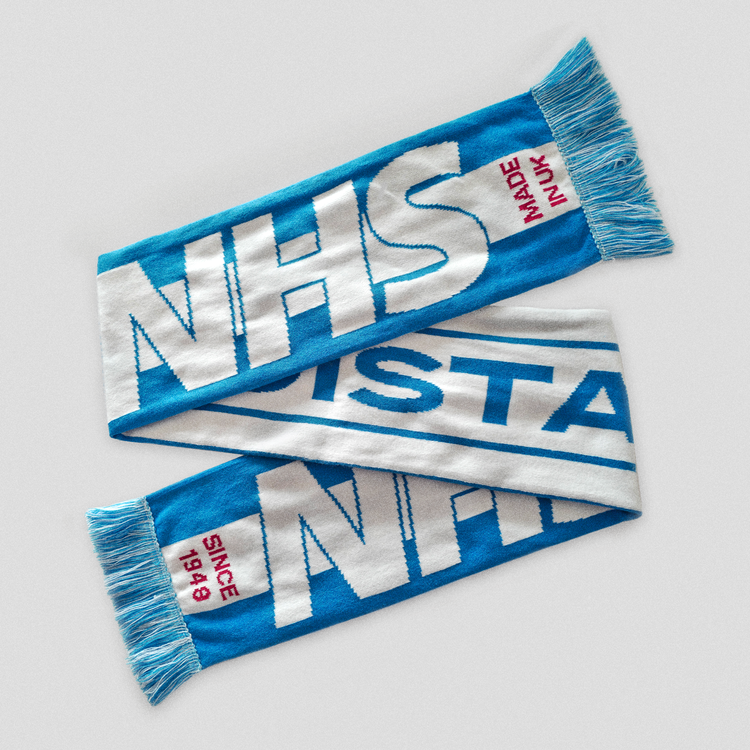
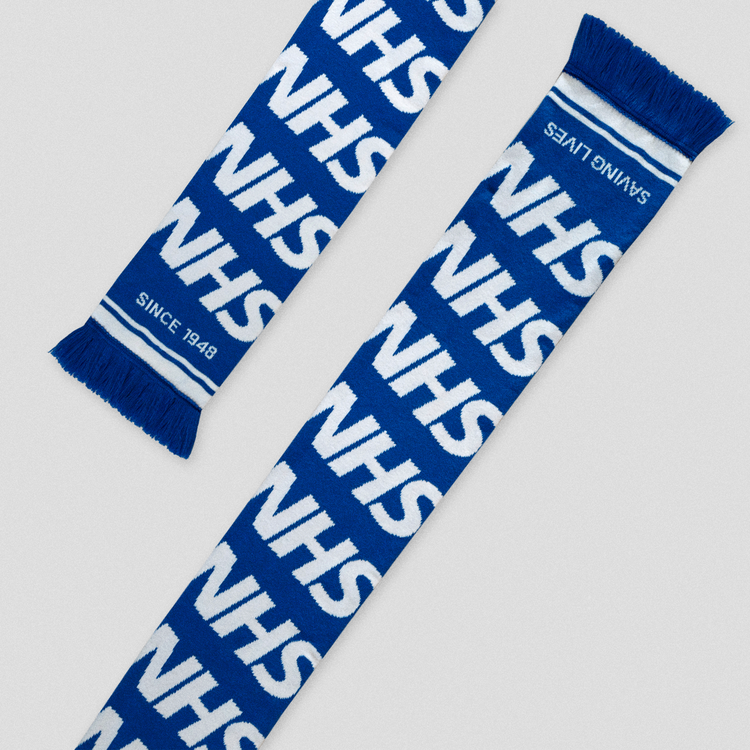
They tend to do limited runs of these so you need to get in there quick.
You can pick up one of two designs from
https://www.originssound.com/shop £19.99
3. I couldn’t make this list without adding this. A volume of songs entitled “You’re not singing anymore”
This is a collection of songs heard on and inspired by the football terraces!
I spent many months researching them, re-working them and talking to football fans to create this ode to the beautiful game and the art of terrace singing. Available on CD, this would be a perfect gift for any football (or folk!) fan to find under the tree on Christmas morning
Available to order from the below link for £10
https://minniebirch.bandcamp.com/album/youre-not-singing-anymore
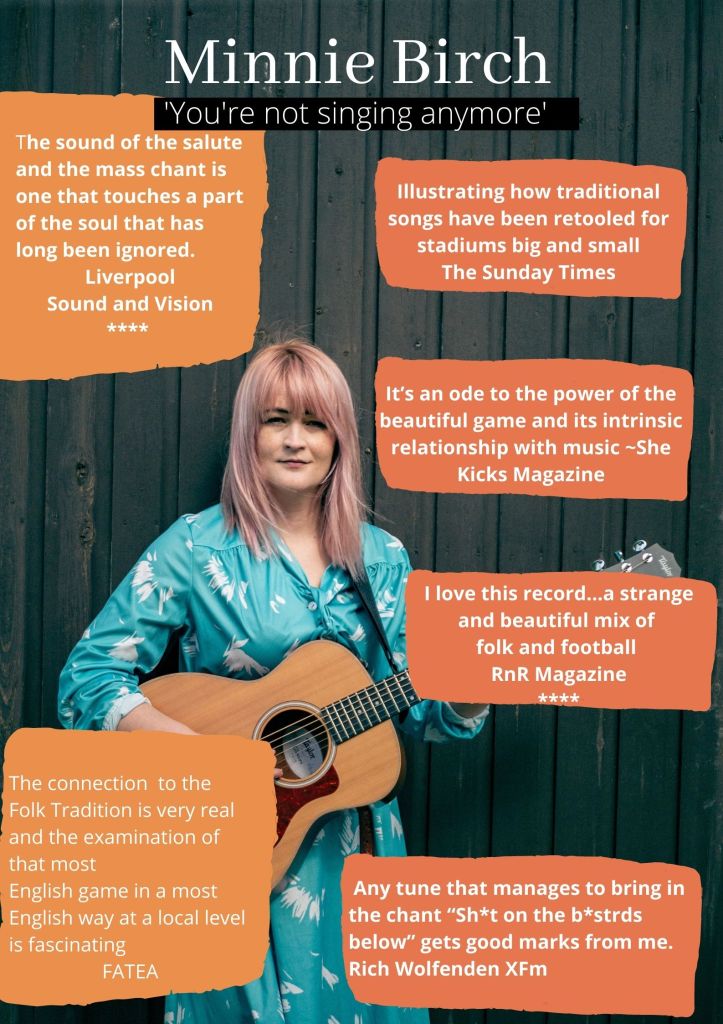
4. This book just came across my radar, it will be hot off the press this Christmas and I am definitely adding it to my list. Here’s the pre-publication details…
In Get Your Head in the Game, Dominic Stevenson, a writer, player, coach, and lifelong football obsessive, interviews a diverse cross-section of characters in the football world, from fans to managers, from players at the start of their careers to retired veterans, women’s football stars, international celebrities, refugee footballers and mental health professionals. He uproots the connections between the sport and the mind, unpicking the subtle interplay between the two; telling the stories of personal battles both on and off the pitch, he touches on anxiety, depression, discrimination, trauma, identity and recovery.
Available from a wide range of booksellers, here is the Waterstones Link. £12.99
https://www.waterstones.com/book/get-your-head-in-the-game/dominic-stevenson/9781786784353
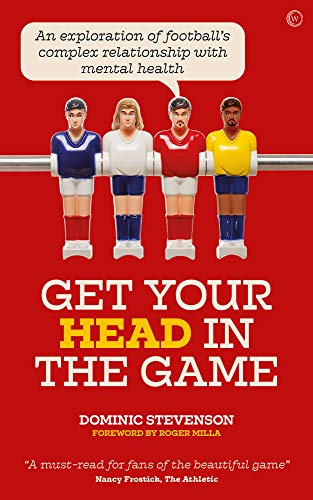
5 You can still pick up the football club edition Remembrance Poppy Pins
from https://www.poppyshop.org.uk/collections/sports-collectibles giving a little something to a good cause at the same time as getting some Christmas shopping done. £4.99
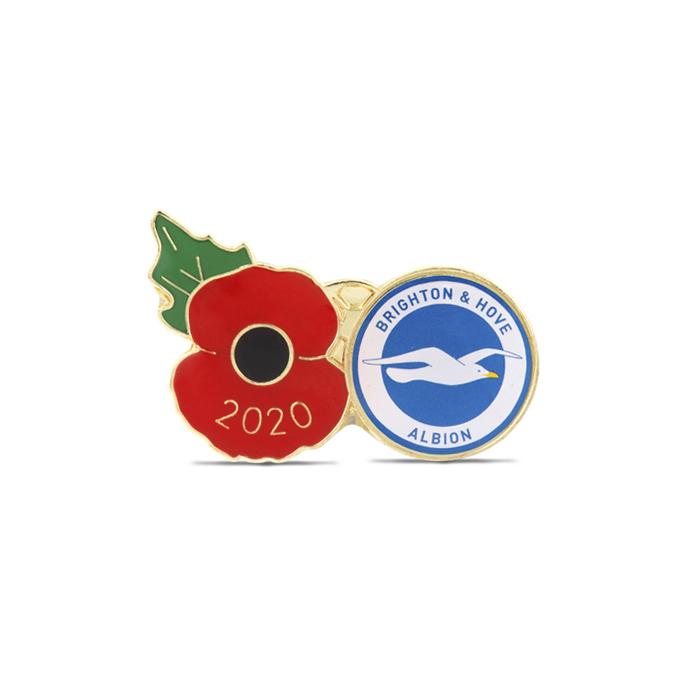

6 These are really adorable, and a perfect way to football theme the traditional Chocolate Orange. “Crochet by JaneyBee” creates these cute football bobble hats for your orange (or bath bomb) along with some other lovely homemade gifts on her Etsy page. Hats are £3.00
https://www.etsy.com/uk/shop/crochetbyjaneybee/
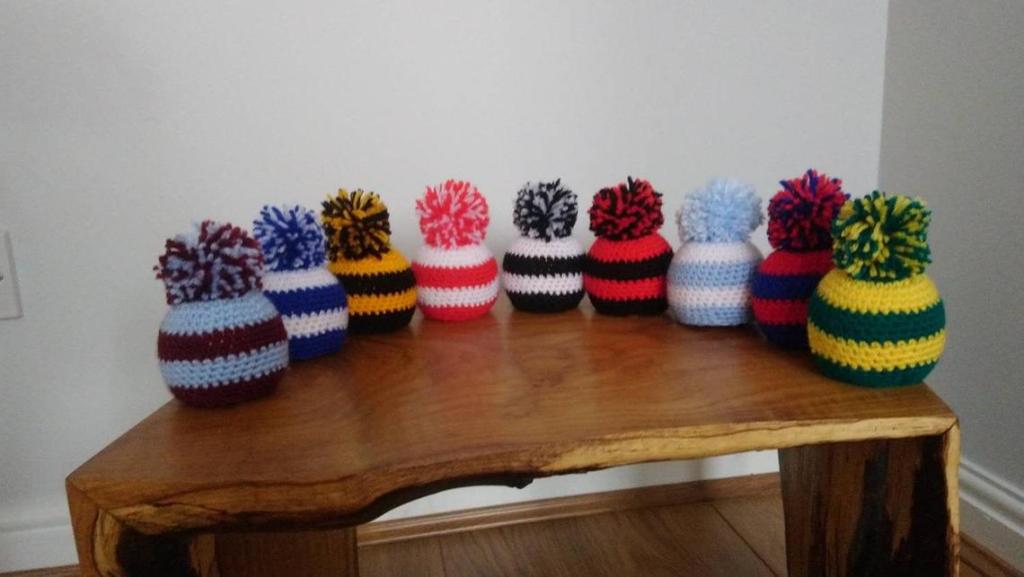
7. These cards aren’t just for Christmas, they are for anytime you want to tell someone you love them more than that time Deeney scored. They have a whole football range, they also have a Christmas range too! Definitely worth a look for a slightly more unique take on your Christmas cards this year.
https://www.atowncalledhome.co.uk/collections/football-cards

8 Another book for the list. This time by photographer Stuart Roy Clarke. This book really is quite special. I have never really owned a “Coffee table” book before, but this is so beautiful that I keep it out on display. It captures the intricacies of the beautiful game in such a unique way and the pictures springboard many a talking point.
Available from the below link £25
https://www.homesoffootball.co.uk/collections/-p129123336
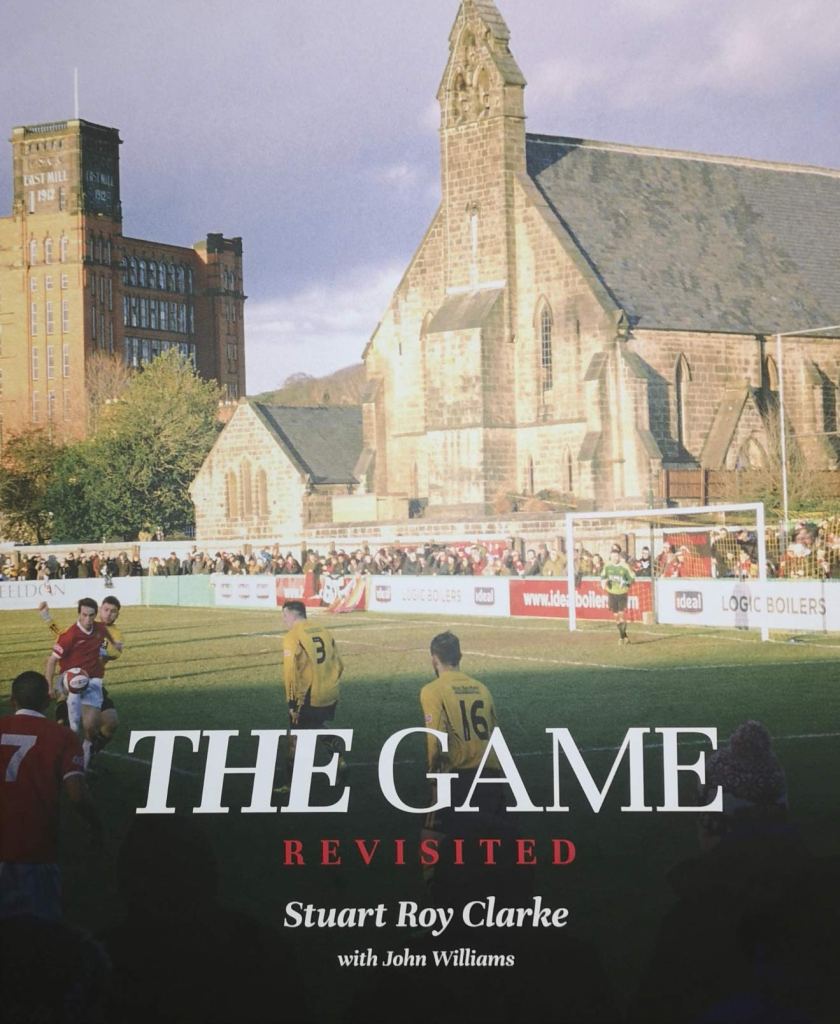
9 Team prints. “Good Team on paper” specialise in those classic Team Kit prints, they can create you almost anything but I really like their personalised options
“From Junior Football squads & School Rugby sides to local Cricket orders, we really can design any team, you tell us the line up and we will print & frame it for you. It might be Hartlebourgh United’s Under 11s for the upcoming season, last years Dalton Year 9 cup winning side or little Al’s first ever team from 2011, it’s up to you, we will do everything we can to give you the print you want. Hockey, Basketball, Volleyball, Baseball, American Football, any team sports, just let us know”
Find out more of what they have available here. Personalised prints £26.
https://goodteamonpaper.com/

10. Ok, this one is getting adding here because it is one of my favourite books. I read it early on in my journey of falling for the beautiful game and the community, friendships, hardships, identity and sense of self that football had given to the writer stayed with me.
“Five-a-Side football is where you play the beautiful game for love, not money. You play it for life and you play it everywhere. Your kit is damp and your legs are a leopard’s back of bruises. Shirts are often tight around the belly, with your hero’s name plastered across your shoulder blades. The showers are too cold in winter and too hot in summer…This is a book for all of us – school mates, work colleagues, total strangers – bonded by the desire to blast one into the net from two feet away
Available from Waterstones for £9.99 (or do check in with your local booksellers)
https://www.waterstones.com/book/above-head-height/james-brown/9781786481788
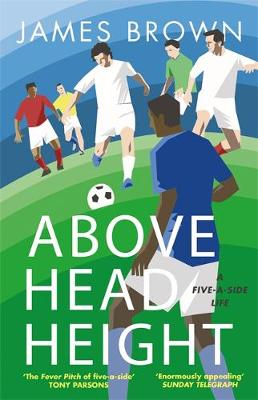
11..Oh, ok so more than 10! Ok so this brings us to our final gift. And this one really isn’t an independent seller, small business or a unique Christmas gift. In fact, it is perhaps the most bought and most obvious gift but, hey…this one comes with a football twist….because, is it really Christmas if you aren’t arguing over monopoly?
There are several different versions available ranging from Premier League Teams to All Stars. They already seem to be sold out in places like Argos and John Lewis so your best bet is Ebay – or the individual club shops.
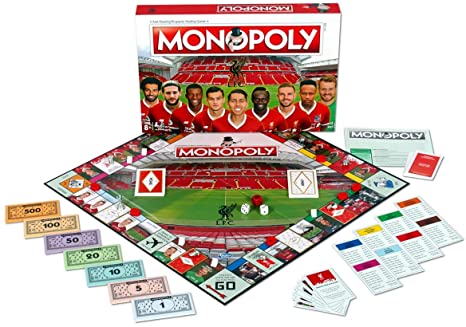
So ends my round up of the best Christmas gifts for a football fan, I really hope they were of some use to you. Although if you really want to go unique and homemade then I highly recommend making your own Table Football…which I found myself doing in early lockdown! You can see evidence of that at the below link
Making a Fussball Table
How Roller Derby prepared me for a Pandemic.
Over the summer and this past month myself and Robert Lane have been hosting some online chats about this and that – the most recent of these with Chris Keniger and Roxanne de Bastion, it was a really interesting and insightful, funny and realistic chat about “Pivoting” in a pandemic.
Both Chris and Roxanne have creative careers and have navigated very creative ways of managing those careers in this strangest of times. I shall link to the chat if you’d like to take a listen.
Here it is
My main take away from it was to embrace all of the things…try the ideas, be flexible, cry if you need to, do nothing if you need to, persevere, take a nap, be angry, be positive, push forward, hibernate…and feel free to change tact at any point. This isn’t just career advice it is life advice.
So, this word…Pivot, has come up a lot this year. People are pivoting their business models to make ends meet, to carry on and to make things work. People are pivoting their lives to manage home-schooling, lock down, Life with little loo roll – whatever it is, we are all being asked/forced to make and embrace change.
Pivot is not a word I used day to day prior to March but it is one I used on Sunday mornings at Roller Derby training.
Let’s assume for a minute you aren’t sure what roller derby is and let me just drag you up to speed…
Here’s a snappy definition from sfvrollerderby.com
“Roller derby is played on an oval track. Players called “jammers” attempt to pass groups of players called “the pack.” This involves somewhat simultaneous defense and offense, resulting in a great sport to watch. Roller derby is a full contact sport played at a break-neck speed — on rollerskates!!
Hidden in the “Pack” is a player who takes on the role of the Pivot. The Pivot has extra responsibilities to other players in the pack, they can be identified because their helmet has a coloured stripe down the middle. They are often the leader, telling the rest of the pack what to do, making decisions and switching up at a fast pace in almost impossible and ever changing circumstances -Roller Derby is full contact carnage!! ( with sensible rules and full safety gear)
The pivot helps the jammer get through the pack by physically sweeping opposing blockers out of their way so they can make it through, the pivot is constantly switching and sacrificing their position to make a clean line for the Jammer. However, if the Jammer really can’t carry on then they can perform what is known as a “Star pass” taking the cover off of their helmet and handing it to the pivot who places it over their striped helmet and assumes the jammer position.
The position of the pivot is essentially to organise, plan, do their darndest to get that Jammer through and then if all else fails they volunteer as tribute, take the star pass and tackle the opposing team directly themselves.
That role is a lovely analogy for these times. We can all be the pivot. We can all plan, and encourage others, and mix it up and switch and take the lead role.. and when the tough stuff gets too tough for others, we can take that star pass, take the burden and give others a break.
But remember we can also be part of the pack, the sturdy wall of players who fend off the opposing forces, who listen to and heed the advice and do what they can to be a team player without charging full throttle through the opposing pack.
We can also all be a jammer – the star of the show, the zippy fast mover who the audience love and want to see- we can be that player and also know that it is ok to occasionally take a moment, realise we are overwhelmed and outnumbered and pass the star to somebody else.
Focus on the negatives!
“Wait? what? This title is not very Minnie-ish or really what anyone wants to hear right now – there is quite enough negative thankyouverrrrymuch!” – I know, I know but stick with me!
Last night myself and Robert Lane had the pleasure of hosting a live stream chat with Neil King (Fatea) and Jo Elkington (Fancourt Music) We have both been live streaming a lot during this period and in July we did a stream a week. We’ve built up a nice little community in our group(Minnie Birch and Robert Lane gigs) . and we wanted to keep that conversation and community going but both feel we wanted to not let the live stream get “dull” or “overdone” (a consideration many people are navigating right now – how do we take a way of sharing music which was new, useful and innovative four months ago and keep breathing new life in to it? ) We decided we’d like to have a live chat that reflects Robert’s successful podcast (Creative Careers Podcast)which is all about … creative careers, we would invite other people on from all sectors of the industry and have chats about the current situation, how it is effecting them in their roles and what might the future look like.
The first was last night, and my take away point was; BE MORE NEGATIVE! but hold up, hear me out there is method in the madness.
Neil and Jo are likely two people who need no introduction to those who read my blog, but in brief, Neil is a magazine editor and radio host, and Jo is a music agent (although they are both so much more) They are also people who are generous with their time, knowledge and skills, have a desire to grow the folk community as a whole and to support artists to be their best – so ideal candidates for a chat!
They were also willing to say yes to a request to come and chat live about “you know, stuff that’s happening right now with music” – didn’t even ask us to narrow that down a bit!
If you head to our group (link above and I will drop again at the end) you can rewatch the chat in all its chaotic, hot, stormy night realness but here are some of the things I took away.
Neil and Jo introduced themselves by answering our first question “What does the landscape of things look like for you and your role right now/during all this?”
Jo was very honest about the challenges of managing several acts at different stages; tour planning/middle of tour/about to tour, and having to just very quickly switch everything up. She mentioned days of unravelling on the phone/emails and quick decision making. The not knowing if to rebook for the autumn, if insurance was paying out for any venues, how to manage the pre-sale tickets (her acts had those in hundreds) and what to do next?! The positives she spoke of were how everyone involved had pulled together at this time – which I think is something we’ve seen across most communities/industries on the ground. It was also very clear that Jo’s number one priority (as she herself sat watching months of work unravel and not being sure of her own financial future) were her clients. The musicians were her main focus. Jo’s knowledge of the industry and the current issues are second to none, she can reel off stats of those effected and knows what’s happening within the political landscape, with the movers and shakers of the folk world and how artists on the ground are coping, it was great to have her insight and I have had a few inboxes since last night saying how much people got from the chat;
“Great stream tonight. Wasn’t sure how interested I’d be (not being a musician), but it was incredibly informative and entertaining”
Neil talked about the very real issues facing the industry but also how Radio has come in to it’s own during this time providing community and support for people in lockdown and providing musicians with an opportunity to still be heard! He looked at some of the progressive things happening with Beardy Folk festival as an example of how something can push ahead during all this and be a road map for what things could look like, but he also talked about the importance of the political landscape and that one of the challenges is that MPs aren’t necessarily aware of the real contribution music makes to communities and the economy – how many people are effected by the halt of live events – so there’s a battle on two fronts -There’s the “how do we safely move forward?” but also the struggle of being heard and recognised as a sector which needs more real support and an awareness of the many people in the industry who have fallen through the gaps for receiving any financial support during all this.
Some stats from our chat
19% of musicians are considering quitting their careers (Musicians Union survey)
36% of public surveyed still feel wary of attending live performances (Guardian)
38% of musicians didn’t qualify for any financial support through Government schemes (Musicians Union)
The #wemakeevents campaign – which looks at all those in the entertainment sector is calling for some clear key action
– Grants not loans!
– Extension of Furlough schemes
– Self Employment schemes to reflect and be tailored to the events industry.
I wont go on much longer as the chat is there for you to have a listen to, and I would recommend it. I would also recommend following the work of Jo and Neil for further insight. In particular Neil’s work with Fatea who have covered some of these issues and who have (and I hope will continue to) run workshops to further musician’s knowledge of the industry they find themselves in.
But why did I call this blog “FOCUS ON THE NEGATIVES!” Well when talking last night I focused on some of the positives – having had more time to create, network, engage with listeners – that seems to be my go to, to look at the positives. But the message I felt I got from Jo and Neil is – that’s all very nice but across the sector are mass redundancies, venues shutting, agents with no income now or for the foreseeable future, self-employed people with no government support who still can not work, a genuine concern that the people and spaces who make our industry what it is are not going to be there when we are able to perform again. That we aren’t being considered. That this “oh but we’ve got some good out of it” is useful for your personal focus and well-being but doesn’t really help to navigate the political terrain. We have to be realistic and we have to be pro-active and that calls on us to focus on what is happening, even if it is negative….especially if it is negative.
If I am honest in my reflections, perhaps a willingness to focus on the positives, talk openly about the luxury of being able to write, and a willingness to see music as a comfort to people in lockdown and hand it all over for free on a less than quality stream is part of the problem (don’t get me wrong, there are spaces and places for this but it did get me thinking about what my role could be in supporting the industry in a “better” way and that perhaps I haven’t always been getting it right)
So what’s an actionable thing I can do to be part of the solution?
Both Jo and Neil were clear on this – ENGAGE IN THE POLITICAL PROCESS.
This was eye-opening for me, as someone who has written to their MP many times, campaigned, signed petitions, fundraised, volunteered, lobbied in Parliament etc etc on many causes close to my heart I have NEVER once stopped and thought that now is the time to be doing this for the industry I so dearly love…odd but not unusual I think to perhaps forget to fight the battle that is closest to you?! To essentially stand up for yourself.
David. J. Hoyland dropped this useful link from the Musicians Union please do go, read, write to your MP, sign the petitions, call for change and be a NEGATIVE voice for once 🙂
It’s never been more important to focus on the negatives!!
Many thanks to those who brought their voices to the chat last night too.
Hope to see you next time
Minnie x